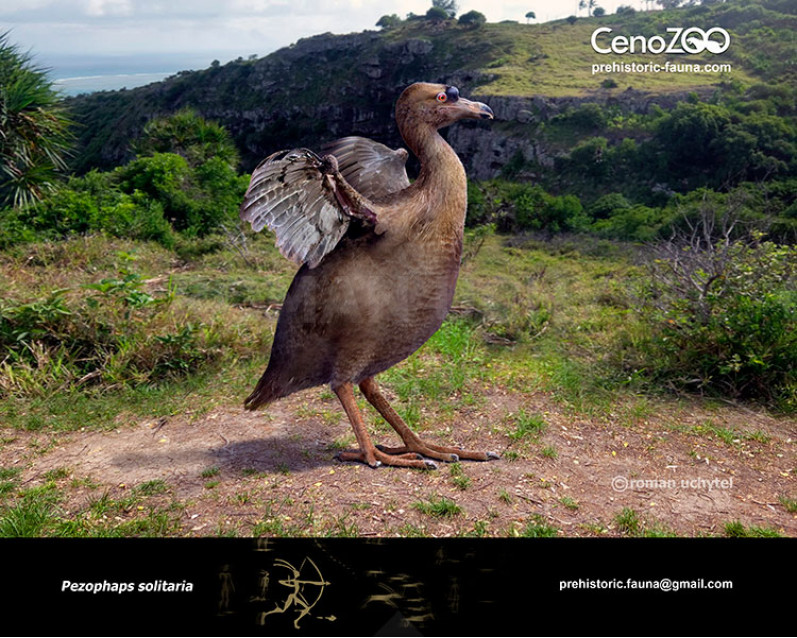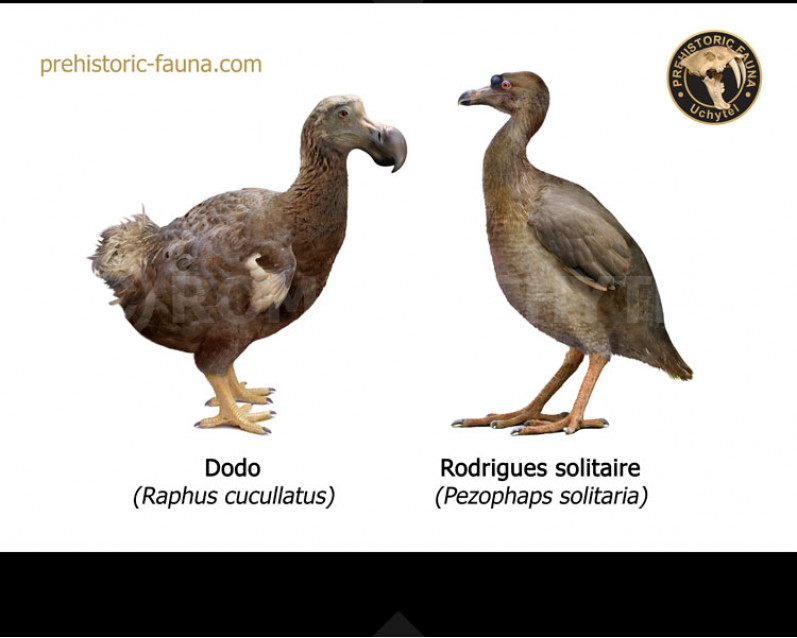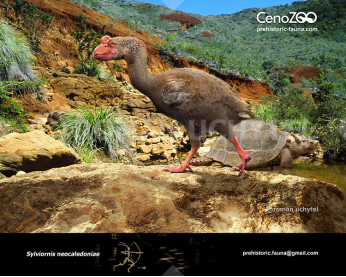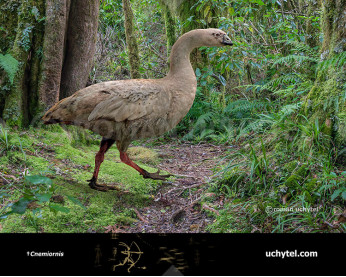Rodrigues solitaire
28812881
Rodrigues solitaire (†Pezophaps solitaria (Gmelin, 1789))
Order: Columbiformes
Family: Columbidae
Dimensions: lwas about 1 m tall and may have weighed 18–28 kg in the wild.
Temporal range: endemic to the island of Rodrigues in the Indian Ocean. Extinction date of 18th century
The Rodrigues solitaire is an extinct flightless bird genetically within the family of pigeons and doves. t was endemic to the island of Rodrigues, east of Madagascar in the Indian Ocean and most closely related to the also extinct dodo of the nearby island Mauritius, the two forming the subfamily Raphinae.
Rodrigues solitaires grew to the size of swans, males were much larger than females and measured up to 90 centimetres in length and 18-28 kilograms in weight. Its plumage was grey and brown and had a black band at the base of its slightly hooked beak, and its neck and legs were long. This birds were highly territorial, with large bony knobs on their wings. They presumably settled disputes by striking each other with their wings; to aid this purpose, they used the knobs on their wrists. Fractures in their wing bones also indicate that they were used in combat. It has also been suggested that these fractures may have been the result of a hereditary bone disease rather than battle-injuries. But in all extant birds where carpal spurs and knobs are present, these are used as weapons without exceptions. Since Rodrigues receives less rainfall and has more seasonal variation than Mauritius, which would have affected the availability of resources on the island, the Rodrigues solitaire would have more reason to evolve aggressive territorial behaviour. Several accounts state that they also defended themselves with a powerful bite. The Rodrigues solitaire laid a single egg that was incubated in turn by both sexes. Gizzard stones helped digest its food, which included fruit and seeds.
First mentioned during the 17th century, the Rodrigues solitaire was extinct by the late 18th century. It was hunted by humans and introduced animals. Apart from account and drawing, and a few other contemporary descriptions, nothing was known about the bird until a few subfossil bones were found in a cave in 1786. Thousands of bones have subsequently been excavated.
The Nicobar pigeon is their closest living genetic relative.
Payment
You may use multiple payment methods to buy image such as credit cards, PayPal and bank transfer.
Rodrigues solitaire (†Pezophaps solitaria (Gmelin, 1789))
Order: Columbiformes
Family: Columbidae
Dimensions: lwas about 1 m tall and may have weighed 18–28 kg in the wild.
Temporal range: endemic to the island of Rodrigues in the Indian Ocean. Extinction date of 18th century
The Rodrigues solitaire is an extinct flightless bird genetically within the family of pigeons and doves. t was endemic to the island of Rodrigues, east of Madagascar in the Indian Ocean and most closely related to the also extinct dodo of the nearby island Mauritius, the two forming the subfamily Raphinae.
Rodrigues solitaires grew to the size of swans, males were much larger than females and measured up to 90 centimetres in length and 18-28 kilograms in weight. Its plumage was grey and brown and had a black band at the base of its slightly hooked beak, and its neck and legs were long. This birds were highly territorial, with large bony knobs on their wings. They presumably settled disputes by striking each other with their wings; to aid this purpose, they used the knobs on their wrists. Fractures in their wing bones also indicate that they were used in combat. It has also been suggested that these fractures may have been the result of a hereditary bone disease rather than battle-injuries. But in all extant birds where carpal spurs and knobs are present, these are used as weapons without exceptions. Since Rodrigues receives less rainfall and has more seasonal variation than Mauritius, which would have affected the availability of resources on the island, the Rodrigues solitaire would have more reason to evolve aggressive territorial behaviour. Several accounts state that they also defended themselves with a powerful bite. The Rodrigues solitaire laid a single egg that was incubated in turn by both sexes. Gizzard stones helped digest its food, which included fruit and seeds.
First mentioned during the 17th century, the Rodrigues solitaire was extinct by the late 18th century. It was hunted by humans and introduced animals. Apart from account and drawing, and a few other contemporary descriptions, nothing was known about the bird until a few subfossil bones were found in a cave in 1786. Thousands of bones have subsequently been excavated.
The Nicobar pigeon is their closest living genetic relative.


-797x638.jpg)


-70x56.jpg)

1-346x277.jpg)

